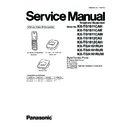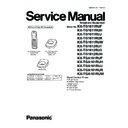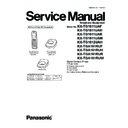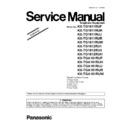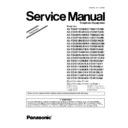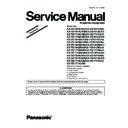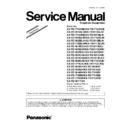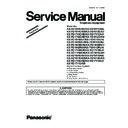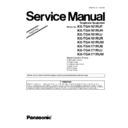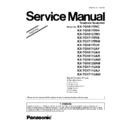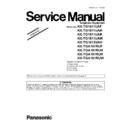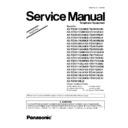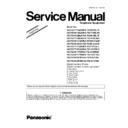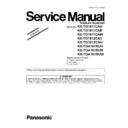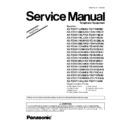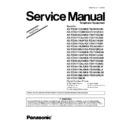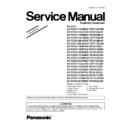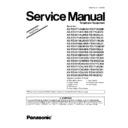Panasonic KX-TG1611CAH / KX-TG1611CAR / KX-TG1611CAW / KX-TG1612CA3 / KX-TG1612CAH / KX-TGA161RUH / KX-TGA161RUR / KX-TGA161RUW Service Manual ▷ View online
3
KX-TG1611CA/KX-TG1612CA/KX-TGA161RU
TABLE OF CONTENTS
PAGE
PAGE
1 Safety Precautions----------------------------------------------- 4
1.1. For Service Technicians --------------------------------- 4
2 Warning -------------------------------------------------------------- 4
2.1. Battery Caution--------------------------------------------- 4
2.2. About Lead Free Solder (PbF: Pb free)-------------- 4
2.3. Discarding of P.C. Board--------------------------------- 5
2.2. About Lead Free Solder (PbF: Pb free)-------------- 4
2.3. Discarding of P.C. Board--------------------------------- 5
3 Specifications ----------------------------------------------------- 6
4 Technical Descriptions ----------------------------------------- 7
4 Technical Descriptions ----------------------------------------- 7
4.1. Block Diagram (Base Unit) ------------------------------ 7
4.2. Circuit Operation (Base Unit) --------------------------- 8
4.3. Block Diagram (Handset)-------------------------------10
4.4. Circuit Operation (Handset)----------------------------11
4.5. Circuit Operation (Charger Unit) ----------------------11
4.6. Signal Route -----------------------------------------------12
4.2. Circuit Operation (Base Unit) --------------------------- 8
4.3. Block Diagram (Handset)-------------------------------10
4.4. Circuit Operation (Handset)----------------------------11
4.5. Circuit Operation (Charger Unit) ----------------------11
4.6. Signal Route -----------------------------------------------12
5 Location of Controls and Components ------------------13
6 Installation Instructions ---------------------------------------13
7 Operating Instructions-----------------------------------------13
6 Installation Instructions ---------------------------------------13
7 Operating Instructions-----------------------------------------13
7.1. For Service Hint-------------------------------------------13
8 Service Mode -----------------------------------------------------14
8.1. Engineering Mode ----------------------------------------14
9 Troubleshooting Guide ----------------------------------------18
9.1. Troubleshooting Flowchart -----------------------------18
9.2. Troubleshooting by Symptom (Base Unit and
9.2. Troubleshooting by Symptom (Base Unit and
Charger Unit) ----------------------------------------------24
9.3. Troubleshooting by Symptom (Handset) -----------27
10 Disassembly and Assembly Instructions ---------------30
10.1. Disassembly Instructions -------------------------------30
10.2. How to Replace the Handset LCD -------------------33
10.2. How to Replace the Handset LCD -------------------33
11 Measurements and Adjustments---------------------------34
11.1. The Setting Method of JIG (Base Unit) -------------34
11.2. Adjustment Standard (Base Unit)---------------------36
11.3. Adjustment Standard (Charger Unit)-----------------37
11.4. The Setting Method of JIG (Handset) ---------------38
11.5. Adjustment Standard (Handset) ----------------------40
11.6. Things to Do after Replacing IC ----------------------41
11.7. RF Specification-------------------------------------------42
11.8. How to Check the Handset Speaker or
11.2. Adjustment Standard (Base Unit)---------------------36
11.3. Adjustment Standard (Charger Unit)-----------------37
11.4. The Setting Method of JIG (Handset) ---------------38
11.5. Adjustment Standard (Handset) ----------------------40
11.6. Things to Do after Replacing IC ----------------------41
11.7. RF Specification-------------------------------------------42
11.8. How to Check the Handset Speaker or
Receiver ----------------------------------------------------43
11.9. Frequency Table (MHz) ---------------------------------43
12 Miscellaneous ----------------------------------------------------44
12.1. How to Replace the Flat Package IC----------------44
12.2. How to Replace the Shield Case ---------------------46
12.3. Terminal Guide of the ICs, Transistors, Diodes
12.2. How to Replace the Shield Case ---------------------46
12.3. Terminal Guide of the ICs, Transistors, Diodes
and Electrolytic Capacitors-----------------------------48
13 Schematic Diagram ---------------------------------------------49
13.1. For Schematic Diagram---------------------------------49
13.2. Schematic Diagram (Base Unit) ----------------------50
13.3. Schematic Diagram (Handset) ------------------------51
13.4. Schematic Diagram (Charger Unit) ------------------52
13.2. Schematic Diagram (Base Unit) ----------------------50
13.3. Schematic Diagram (Handset) ------------------------51
13.4. Schematic Diagram (Charger Unit) ------------------52
14 Printed Circuit Board-------------------------------------------53
14.1. Circuit Board (Base Unit) -------------------------------53
14.2. Circuit Board (Handset) ---------------------------------55
14.3. Circuit Board (Charger Unit) ---------------------------57
14.2. Circuit Board (Handset) ---------------------------------55
14.3. Circuit Board (Charger Unit) ---------------------------57
15 Exploded View and Replacement Parts List -----------58
15.1. Cabinet and Electrical Parts (Base Unit) -----------58
15.2. Cabinet and Electrical Parts (Handset) -------------59
15.3. Cabinet and Electrical Parts (Charger Unit) -------60
15.4. Accessories ------------------------------------------------61
15.2. Cabinet and Electrical Parts (Handset) -------------59
15.3. Cabinet and Electrical Parts (Charger Unit) -------60
15.4. Accessories ------------------------------------------------61
15.5. Replacement Part List ---------------------------------- 62
4
KX-TG1611CA/KX-TG1612CA/KX-TGA161RU
1 Safety Precautions
1.1.
For Service Technicians
• Repair service shall be provided in accordance with repair technology information such as service manual so as to
prevent fires, injury or electric shock, which can be caused by improper repair work.
1. When repair services are provided, neither the products nor their parts or members shall be remodeled.
2. If a lead wire assembly is supplied as a repair part, the lead wire assembly shall be replaced.
3. FASTON terminals shall be plugged straight in and unplugged straight out.
2. If a lead wire assembly is supplied as a repair part, the lead wire assembly shall be replaced.
3. FASTON terminals shall be plugged straight in and unplugged straight out.
• ICs and LSIs are vulnerable to static electricity.
When repairing, the following precautions will help prevent recurring malfunctions.
1. Cover plastic parts boxes with aluminum foil.
2. Ground the soldering irons.
3. Use a conductive mat on worktable.
4. Do not grasp IC or LSI pins with bare fingers.
2. Ground the soldering irons.
3. Use a conductive mat on worktable.
4. Do not grasp IC or LSI pins with bare fingers.
2 Warning
2.1.
Battery Caution
1. Danger of explosion if battery is incorrectly replaced.
2. Replace only with the same or equivalent type recommended by the manufacturer.
2. Replace only with the same or equivalent type recommended by the manufacturer.
3. Dispose of used batteries according to the manufacture’s Instructions.
2.2.
About Lead Free Solder (PbF: Pb free)
Note:
In the information below, Pb, the symbol for lead in the periodic table of elements, will refer to standard solder or solder that
contains lead.
We will use PbF solder when discussing the lead free solder used in our manufacturing process which is made from Tin (Sn),
Silver (Ag), and Copper (Cu).
This model, and others like it, manufactured using lead free solder will have PbF stamped on the PCB. For service and repair
work we suggest using the same type of solder.
contains lead.
We will use PbF solder when discussing the lead free solder used in our manufacturing process which is made from Tin (Sn),
Silver (Ag), and Copper (Cu).
This model, and others like it, manufactured using lead free solder will have PbF stamped on the PCB. For service and repair
work we suggest using the same type of solder.
Caution
• PbF solder has a melting point that is 50
°F ~70°F (30°C ~ 40°C) higher than Pb solder. Please use a soldering iron with
temperature control and adjust it to 700
°F ± 20°F (370°C ± 10°C).
• Exercise care while using higher temperature soldering irons.: Do not heat the PCB for too long time in order to prevent solder
splash or damage to the PCB.
• PbF solder will tend to splash if it is heated much higher than its melting point, approximately 1100
°F (600°C).
• When applying PbF solder to double layered boards, please check the component side for excess which may flow onto the
opposite side (See the figure below).
component
component
pin
pin
solder
remove all of the
excess solder
excess solder
slice view
5
KX-TG1611CA/KX-TG1612CA/KX-TGA161RU
2.2.1.
Suggested PbF Solder
There are several types of PbF solder available commercially. While this product is manufactured using Tin, Silver, and Copper
(Sn+Ag+Cu), you can also use Tin and Copper (Sn+Cu) or Tin, Zinc, and Bismuth (Sn+Zn+Bi). Please check the manufacturer’s
specific instructions for the melting points of their products and any precautions for using their product with other materials. The
following lead free (PbF) solder wire sizes are recommended for service of this product: 0.3 mm, 0.6 mm and 1.0 mm.
(Sn+Ag+Cu), you can also use Tin and Copper (Sn+Cu) or Tin, Zinc, and Bismuth (Sn+Zn+Bi). Please check the manufacturer’s
specific instructions for the melting points of their products and any precautions for using their product with other materials. The
following lead free (PbF) solder wire sizes are recommended for service of this product: 0.3 mm, 0.6 mm and 1.0 mm.
2.3.
Discarding of P.C. Board
When discarding P. C. Board, delete all personal information such as telephone directory and caller list or scrap P. C. Board.
0.3 mm X 100 g
0.6 mm X 100 g
1.0 mm X 100 g
6
KX-TG1611CA/KX-TG1612CA/KX-TGA161RU
3 Specifications
Note:
• Design and specifications are subject to change without notice.
Note for Service:
• Operation range: Up to 300 m outdoors, Up to 50 m indoors, depending on condition
• Analog telephone connection: Telephone Line
• Analog telephone connection: Telephone Line
Standard:
DECT (Digital Enhanced Cordless
Telecommunications),
Number of channels:
120 Duplex Channels
Frequency range:
1.88 GHz to 1.90 GHz
Duplex procedure:
TDMA (Time Division Multiple Access)
Channel spacing:
1,728 kHz
Bit rate:
1,152 kbit/s
Modulation:
GFSK (Gaussian Frequency Shift Keying)
RF transmission power:
Approx. 10 m W (average power per channel)
Telecommunications),
Number of channels:
120 Duplex Channels
Frequency range:
1.88 GHz to 1.90 GHz
Duplex procedure:
TDMA (Time Division Multiple Access)
Channel spacing:
1,728 kHz
Bit rate:
1,152 kbit/s
Modulation:
GFSK (Gaussian Frequency Shift Keying)
RF transmission power:
Approx. 10 m W (average power per channel)
Power source (AC Adaptor):
220-240V AC, 50/60 Hz
220-240V AC, 50/60 Hz
Power consumption
Base unit: PNLV226CE0Z
Base unit:
Charger: PNLV226CE0Z
Standby: Approx. 0.6 W
Maximum: Approx. 3.3 W
Charger:
Standby: Approx. 0.1 W
Maximum: Approx. 2.2 W
Maximum: Approx. 3.3 W
Charger:
Standby: Approx. 0.1 W
Maximum: Approx. 2.2 W
Operating conditions:
0
0
°C–40°C, 20%–80% relative air humidity (dry)
Dimensions:
Base unit : Approx. 90 mm x 100 mm x 50 mm
Handset : Approx. 49 mm x 30 mm x 159 mm
Charger: Approx. 72 mm x 76 mm x 43 mm
Base unit : Approx. 90 mm x 100 mm x 50 mm
Handset : Approx. 49 mm x 30 mm x 159 mm
Charger: Approx. 72 mm x 76 mm x 43 mm
Mass (weight):
Base unit : Approx. 100
g
Handset: Approx. 130
g
Charger: Approx. 50
g
■
■
■
■
■
■
■
■
Voice coding:
ADPCM 32 kbit/s
ADPCM 32 kbit/s
■
■
■
■
■
■

